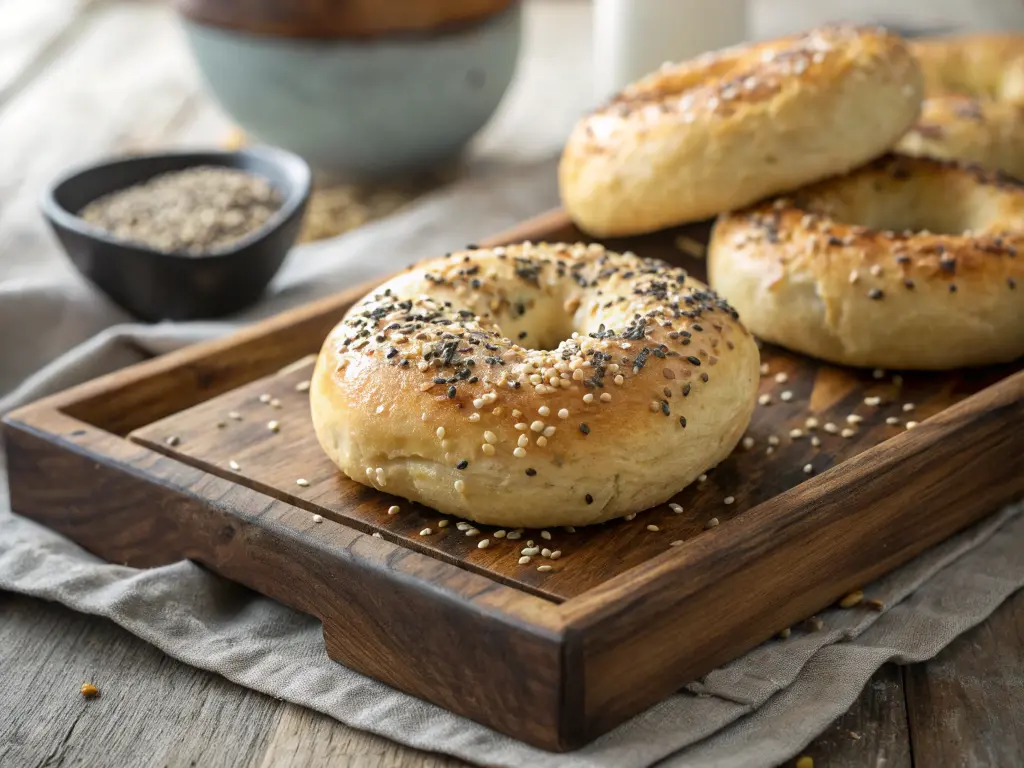Looking for a gluten free bagel recipe that actually delivers on taste, chew, and golden perfection? Whether you’re gluten-intolerant, living with celiac, or simply exploring new healthy baking options, this complete guide will walk you through everything you need to make the best gluten free bagels at home.
In this article, you’ll learn:
- A step-by-step gluten free bagel recipe you can rely on
- The best flours and binders for gluten-free baking
- How to avoid dense, gummy bagels
- Nutritional info, including calories and benefits
- How to make protein-packed gluten free bagels
- Store-bought options vs homemade recipes
Gluten free bagels are more than possible—they’re easy, rewarding, and customizable when you follow the right process. And if you’re multitasking in the kitchen, check out this protein cookie recipe for a healthy treat to enjoy while your bagels rise.
Ready to master the art of the perfect gluten free bagel recipe? Let’s dig in.
Table of Contents
What Makes a Perfect Gluten Free Bagel?
The Science Behind Gluten-Free Baking
The heart of any good gluten free bagel recipe is structure. Unlike regular bagels made with wheat flour, gluten-free versions need help to hold together and rise. That’s where gluten substitutes like psyllium husk, xanthan gum, or flaxseed come into play. These binders act like gluten, giving elasticity and strength to the dough.
If you skip these key ingredients, your gluten free bagel recipe will likely come out crumbly or flat. The right moisture balance is also critical—too wet and the dough gets sticky, too dry and it cracks. It’s a delicate dance, but once you get it right, your bagels will be chewy and satisfying every time.
Key Differences from Traditional Bagels
Let’s compare a traditional bagel to a gluten free bagel recipe side-by-side:
| Feature | Traditional Bagels | Gluten Free Bagel Recipe |
|---|---|---|
| Base Flour | Wheat flour (with gluten) | Gluten-free blends (rice, sorghum, oat) |
| Binding Agent | Gluten | Psyllium husk, xanthan gum |
| Texture | Dense, chewy | Light, chewy if balanced well |
| Boiling Technique | Standard boil-and-bake | Same, with minor adjustments |
| Flavor Profile | Yeasty, neutral | Nutty, mild, varies by flour |
A good gluten free bagel recipe mimics the chew and crust of a classic bagel, while allowing for a range of creative flour combos—from brown rice and oat flour to almond and buckwheat.
Want more simple gluten-free meal ideas? Browse our Quick & Simple section for fast, flavor-packed recipes.
By mastering your ingredients and baking method, your gluten free bagel recipe won’t just be good for gluten free—it’ll be downright delicious.
How to Make Gluten-Free Bagels at Home
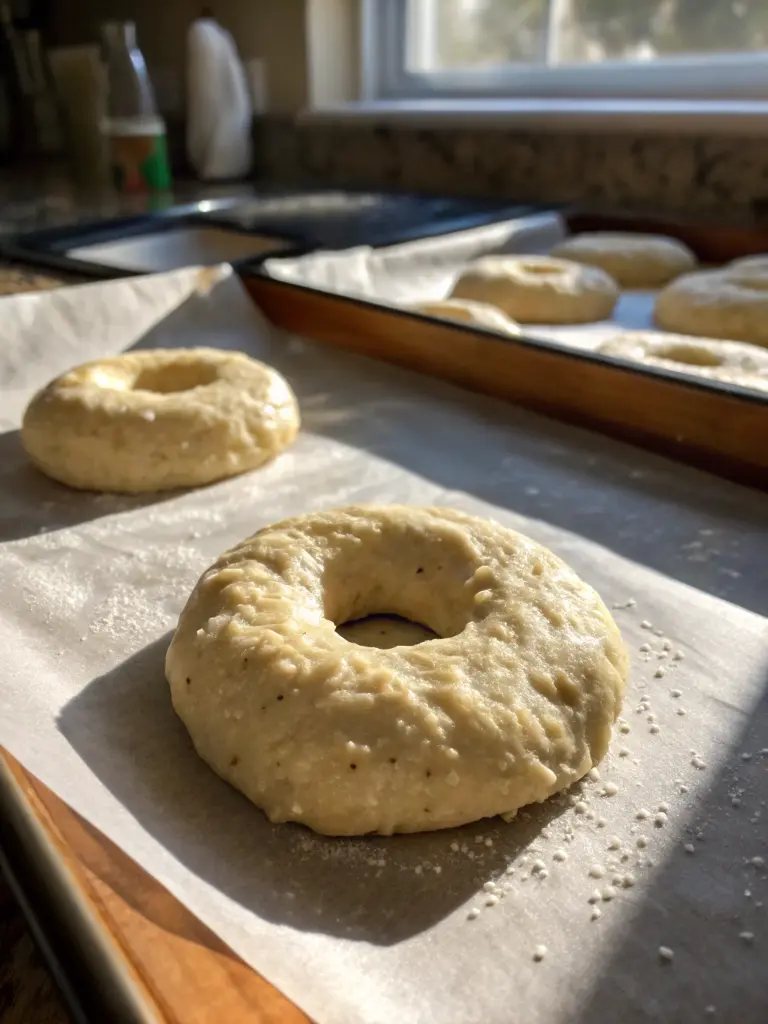
Ingredients You Need for a Perfect Gluten Free Bagel Recipe
The foundation of any successful gluten free bagel recipe starts with high-quality ingredients. While traditional bagels use simple staples like wheat flour and yeast, gluten-free versions call for a few special components to get that chewy, bakery-style texture.
Here’s what you’ll need:
Basic Ingredients:
| Ingredient | Purpose |
|---|---|
| Gluten-free flour blend | The base (choose one with xanthan gum or add it separately) |
| Instant yeast | Helps the bagels rise and get fluffy |
| Warm water | Activates the yeast and hydrates flour |
| Sugar or honey | Feeds the yeast, adds mild sweetness |
| Salt | Boosts flavor and balances taste |
| Xanthan gum (if not in flour blend) | Provides structure and elasticity |
Optional Enhancers:
- Psyllium husk powder – Improves chew and texture
- Apple cider vinegar – Helps yeast activate and rise
- Egg wash or dairy-free milk – Gives that shiny, golden crust
- Toppings like sesame seeds, everything seasoning, or poppy seeds
Tip: Choose a certified gluten-free flour mix that contains a balance of rice flour, tapioca starch, and potato starch for the best results. Some popular brands include Bob’s Red Mill 1-to-1 and King Arthur’s Gluten-Free All-Purpose Flour.
Step-by-Step Gluten Free Bagel Recipe (Boiled & Baked)
Follow this step-by-step guide for a foolproof gluten free bagel recipe:
- Activate the yeast
- In a bowl, combine 1 packet of instant yeast (2¼ tsp) with 1 tbsp sugar and 1 cup of warm water. Let it sit for 5–10 minutes until foamy.
- Mix the dry ingredients
- In a large bowl, whisk together 2½ cups of gluten-free flour, 1 tsp salt, and 1 tsp xanthan gum (if your flour doesn’t contain it). Add 1 tbsp psyllium husk if desired for better texture.
- Combine and knead
- Slowly pour the yeast mixture into the dry ingredients. Add 1 tsp of apple cider vinegar and mix until dough forms. Knead gently with oiled hands for 2–3 minutes. The dough should be soft but not sticky.
- Shape the bagels
- Divide the dough into 6–8 equal parts. Roll each into a ball, then poke a hole in the center with your thumb and gently stretch to form a ring.
- Let the dough rise
- Place shaped bagels on a parchment-lined tray. Cover loosely and let them rise for 30–45 minutes in a warm area.
- Boil the bagels
- Bring a large pot of water to a boil. Add 1 tbsp baking soda. Gently drop 1–2 bagels in at a time, boiling each side for 30 seconds.
- Top and bake
- Preheat the oven to 400°F (200°C). Place the boiled bagels on a lined baking sheet. Brush with egg wash or dairy-free milk, then add toppings if desired.
- Bake for 20–25 minutes or until golden brown and firm to the touch.
- Cool and enjoy
- Let them cool for 10 minutes before slicing. Serve toasted with cream cheese, avocado, or jam.
This gluten free bagel recipe makes about 6–8 standard-sized bagels, depending on size preference. They freeze well and toast up beautifully!
Want a healthy salad to go with your fresh bagels? Don’t miss our Kardashian Salad Recipe for a crunchy, refreshing combo.
Coming up next: we’ll break down the best gluten-free flours you can use to elevate your bagel game!
The Best Gluten-Free Flours for Bagels
Comparing Top Gluten-Free Flour Blends for Bagel Recipes
When it comes to the perfect gluten free bagel recipe, your flour blend is everything. Not all gluten-free flours perform the same—some absorb more water, others create a sandy texture, and a few deliver that chewy, bakery-style bite everyone loves.
Here’s a quick breakdown of the most popular gluten-free flours and how they stack up in bagel-making:
| Flour Type | Texture Output | Flavor Profile | Best Use in Bagels |
|---|---|---|---|
| Rice Flour | Light, slightly dry | Neutral | Use in base blends |
| Tapioca Starch | Chewy and soft | Mild sweetness | Adds stretch |
| Potato Starch | Moist, tender crumb | Neutral | Improves texture |
| Oat Flour | Dense but soft | Mild, slightly sweet | Use with a binder |
| Almond Flour | Nutty, crumbly | Rich & nutty | Combine with others |
| Sorghum Flour | Slightly gritty | Earthy and wheat-like | Add for depth |
A well-balanced gluten free bagel recipe often uses a combination of 2–3 flours. For example, a mix of rice flour, tapioca starch, and potato starch offers a chewy texture with good structure.
Experimenting with flour combinations is key to perfecting your gluten free bagel recipe.
Why Flour Choice Affects Texture and Flavor
Using the right flour blend can mean the difference between dense, doughy bagels and light, chewy ones. Gluten-free flours have no built-in elasticity, so you’ll need to consider:
- Moisture Absorption: Oat and coconut flours absorb more liquid—use less or increase moisture.
- Texture Balance: Combine light (rice) and chewy (tapioca) flours for ideal density.
- Flavor Matching: Almond or sorghum add nuttiness that works well with savory toppings.
- Binder Compatibility: Psyllium husk or xanthan gum must complement your flour combo to mimic gluten’s structure.
Recommended Flour Blends for Beginners:
- Bob’s Red Mill 1-to-1 Baking Flour – Balanced with xanthan gum included
- King Arthur Gluten-Free Measure for Measure – Great for bread-like textures
- Cup4Cup Multipurpose Flour – Slightly richer, good for chewy bagels
If you’re experimenting, always test in small batches and note how each flour changes the chewiness and moisture level of your bagel.
Looking for more fresh ideas using pantry staples? Discover great ideas like our Kardashian Salad Easy Steps—a perfect partner for your warm, toasted bagels.
Next up, we’ll troubleshoot why some gluten-free bagels turn out way too dense and how to fix that.
Common Gluten-Free Bagel Mistakes & Fixes
Why Are My Gluten Free Bagels So Dense?
This is one of the most common questions bakers ask when trying a gluten free bagel recipe: “Why are my bagels so heavy and doughy?”
The culprit is usually a combination of the wrong flour ratio, not enough rising time, or skipping vital ingredients like binders.
Here’s what could be going wrong—and how to fix it:
1. Not Using a Binder (or the Right One)
Gluten-free flours lack the stretch and structure gluten provides. If you skip xanthan gum or psyllium husk, your bagels will fall flat—literally.
Fix: Add 1 teaspoon of xanthan gum or 1 tablespoon of psyllium husk to your dough for elasticity and air retention.
2. Underproofing the Dough
Gluten-free doughs need more rise time to allow air pockets to form. Rushing this step causes heavy, gummy centers.
Fix: Let your shaped bagels rest for 45–60 minutes in a warm spot, or until noticeably puffy.
3. Incorrect Flour Ratios
Too much starchy flour (like rice or tapioca) and not enough structure-building flour leads to overly dense results.
Fix: Use a flour blend with a mix of protein (like sorghum or oat) and starch (like potato or tapioca). Balanced blends yield the best results.
4. Too Much or Too Little Moisture
Getting the hydration level wrong is a recipe for trouble. Dry dough cracks, while wet dough collapses.
Fix: Your dough should feel soft and slightly tacky but still hold its shape when rolled. If it’s too sticky, dust with flour. If it’s dry, add 1 tsp of water at a time.
Tips to Make Bagels Light, Chewy, and Fluffy
Want to go from meh to amazing with your gluten free bagel recipe? Use these pro tips:
- Always boil your bagels before baking. This sets the crust and keeps the inside chewy.
- Use baking soda in your boiling water for better browning and flavor.
- Add a splash of vinegar to your dough. It helps boost the yeast and improves texture.
- Weigh your ingredients instead of scooping. Gluten-free flours are light and can vary by volume.
- Preheat your oven properly (400°F minimum) for even baking.
Here’s a quick cheat sheet:
| Problem | Likely Cause | Quick Fix |
|---|---|---|
| Dense or gummy bagels | Underproofed, wrong flour | Add more rise time, adjust flour |
| Flat bagels | No binder, overhydrated dough | Add xanthan gum, reduce water |
| Dry and crumbly texture | Not enough moisture/binder | Use psyllium husk or extra liquid |
| Pale, undercooked crust | Oven too cool or no boil | Boil with baking soda and preheat oven |
Still struggling? Don’t miss our Quick & Simple section for beginner-friendly gluten-free ideas that turn out every time.
Coming up next, let’s dig into the nutritional breakdown—because yes, you can make healthy bagels without the gluten.
Nutritional Breakdown of Gluten Free Bagels
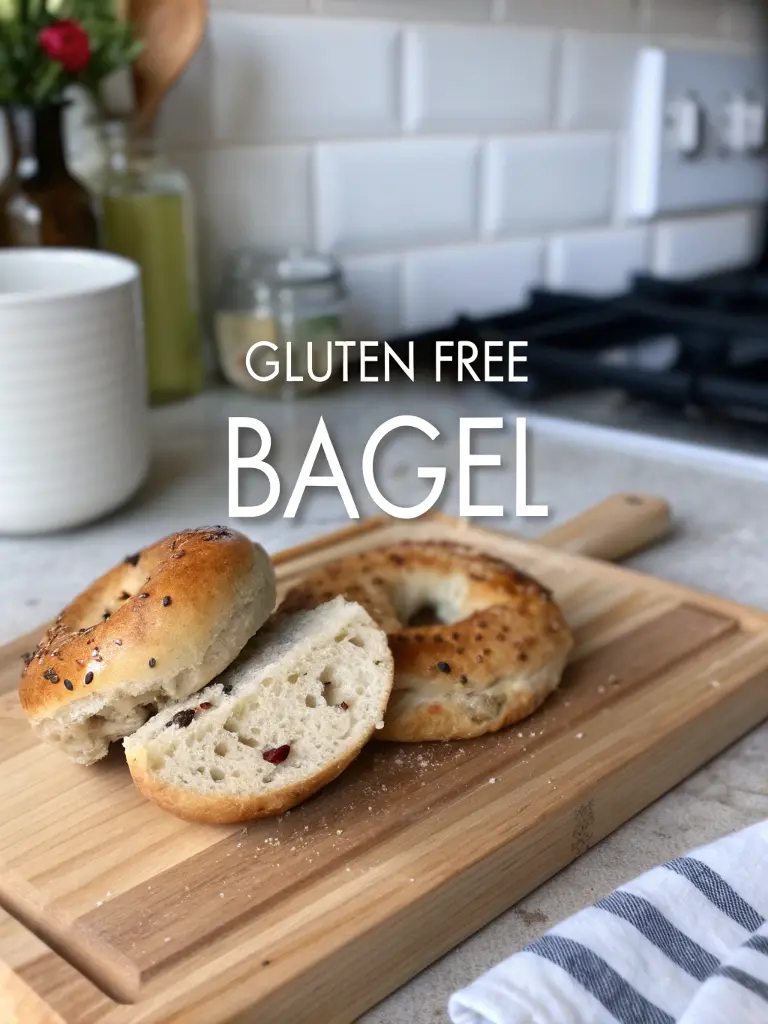
How Many Calories in a Gluten Free Bagel?
If you’re wondering about the calorie count in your average gluten free bagel recipe, here’s the deal:
A standard homemade gluten free bagel contains approximately 180–250 calories, depending on ingredients and size. Add-ins like almond flour, seeds, or protein powders will increase this count.
| Type of Gluten Free Bagel | Average Calories |
|---|---|
| Basic plain (homemade) | 190–210 |
| Store-bought, plain | 200–260 |
| With protein flour or seeds | 230–280 |
| Mini bagels (homemade) | 120–150 |
These numbers make gluten free bagels a relatively light option for breakfast—especially when compared to traditional wheat bagels, which often pack over 300 calories and more carbs.
To reduce calories further, skip sweeteners or brush with olive oil instead of using egg wash.
Macronutrients and Fiber Benefits
A high-quality gluten free bagel recipe is more than just gluten-free—it can be nutrient-dense, too. Depending on your flour choice, these bagels can offer more fiber, healthier fats, and even a solid dose of plant-based protein.
Here’s a nutritional snapshot (per one medium homemade gluten-free bagel):
| Nutrient | Average Value |
|---|---|
| Carbohydrates | 32–38g |
| Protein | 4–6g |
| Fat | 2–5g |
| Fiber | 3–6g |
| Sugar | 1–3g |
Boost nutrition by:
- Using oat flour or buckwheat flour for extra fiber
- Adding chia seeds or flaxseed meal to increase omega-3s
- Subbing in almond flour to raise healthy fat content
- Including pea protein or plant protein powder for muscle-friendly macros
And yes, gluten free doesn’t mean tasteless. Done right, your gluten free bagel recipe can be nutritious, satisfying, and perfect for clean eating lifestyles.
Want more ideas for fiber-rich gluten-free meals? Don’t miss our healthy recipe inspiration here.
Up next: We’ll break down the real health benefits of going gluten-free—and why your bagel habit might be better than ever.
Are Gluten-Free Bagels Healthy?
Gluten Free Bagels Benefits
A common misconception is that gluten-free foods are just “lesser” versions of traditional recipes. But when it comes to a well-made gluten free bagel recipe, it can actually be a healthier option—depending on how it’s made and what ingredients are used.
Here are the key benefits of gluten free bagels:
1. Gentler on Digestion
For anyone with celiac disease, gluten sensitivity, or IBS, gluten can cause inflammation, bloating, or serious gut discomfort. Gluten-free bagels skip the irritants while still offering satisfying texture and taste.
2. Higher in Fiber (When Done Right)
Many gluten free flour blends (especially oat, buckwheat, and sorghum) are naturally rich in fiber. A high-fiber gluten free bagel recipe can support healthy digestion and keep you full longer.
3. Lower Glycemic Index
Flours like almond or coconut help reduce blood sugar spikes. While traditional bagels can spike insulin, gluten-free versions can offer steadier energy—ideal for breakfast.
4. Customizable Nutrients
With a gluten free bagel recipe, you’re not locked into processed wheat flour. Add flaxseeds for omega-3s, pumpkin seeds for zinc, or even collagen for joint support. Your bagel, your rules.
| Benefit | Gluten-Free Bagel Impact |
|---|---|
| Digestive Comfort | No gluten = reduced bloating |
| Fiber | High when using oat or buckwheat |
| Blood Sugar Control | Lower GI with nut-based flours |
| Allergen Friendly | Easy to make dairy/egg/soy-free |
Digestive Perks and Allergen Safety
One of the best parts of baking your own gluten free bagel recipe is control. You can ditch common allergens like:
- Dairy – Use dairy-free milk in your dough or as a wash
- Eggs – Substitute with flax or chia egg
- Soy – Stick with pure flour blends (no soy flour)
- Nuts – Go nut-free using rice or oat-based flours
This means gluten free bagels can be made safe for almost any diet—from vegan to low-FODMAP.
And let’s be real—when you bite into a warm, chewy, freshly baked gluten free bagel made from real food ingredients, it feels like a win for both taste and wellness.
Need a quick gluten-free meal pairing? Discover great ideas like our Kardashian Salad recipe that’ll turn your bagel into a full, nutritious plate.
Next up: Let’s amp up the protein and explore how to make high-protein gluten free bagels the smart way.
Gluten Free Protein Bagels – Yes, It’s Possible
Can You Make Protein Bagels with Gluten Free Flour?
Absolutely—and they’re not just possible, they’re awesome. If you’re following a high-protein diet, working on muscle recovery, or just want a more filling breakfast, a gluten free bagel recipe can be easily upgraded with smart ingredient swaps.
You don’t need fancy powders or expensive mixes. Just the right blend of flours, seeds, and binders can pack serious protein into every bite.
Here are 5 simple ways to add protein to your gluten-free bagels:
| Protein Add-In | Protein per Serving (approx.) | Notes |
|---|---|---|
| Almond flour | 6g | Rich in healthy fats too |
| Pea protein powder | 15–20g | Neutral taste, smooth texture |
| Greek yogurt (dairy-free or regular) | 9g | Moistens dough and boosts protein |
| Ground flaxseed | 3g | Adds fiber and structure |
| Chia seeds | 4g | Gel-like texture helps bind |
Pro Tip: When adding protein powder, reduce the total flour by about 1/4 cup to maintain dough balance. If using Greek yogurt, you may need less water.
High-Protein Flour Blends and Add-Ins
If you’re building your gluten free bagel recipe from scratch and want maximum protein with great structure, try this combo:
DIY Protein Flour Blend (per batch):
- 1 cup almond flour
- 1 cup gluten-free oat flour
- ¼ cup pea protein powder
- 1 tsp psyllium husk
- 1 tsp xanthan gum
- 1 tsp baking powder (optional)
This mix creates a chewy, satisfying base that supports toppings, spreads, or even sandwich fillings.
Topping Ideas for Extra Protein:
- Sprinkle hemp hearts or sesame seeds before baking
- Spread with nut butter, hummus, or whipped tofu
- Add turkey slices or egg for a full protein-packed breakfast
Want a fast, sweet protein snack too? Don’t miss our 10-Minute Protein Cookie Recipe to complement your savory bagels!
Protein-packed, gluten-free bagels prove that healthy doesn’t have to mean boring. You can hit your macros and still enjoy that classic bagel comfort—all without a speck of gluten.
Next up, let’s see how homemade stacks up against what you’ll find in stores (and we’ll answer the big one: What is the best gluten free bagel in the world?)
Store-Bought vs Homemade Gluten Free Bagels
What Is the Best Gluten Free Bagel in the World?
It’s the big question for every bagel lover who’s gone gluten-free:
“What’s the best gluten free bagel in the world?”
The truth? It depends on what you value—flavor, texture, ingredients, or convenience. But one thing’s for sure: a well-crafted gluten free bagel recipe made at home often beats the packaged brands in taste, freshness, and nutrition.
Still, for those busy mornings or snack emergencies, there are a few standout store-bought options that really deliver.
Top 5 Store-Bought Gluten Free Bagel Brands (USA)
| Brand | Notable Features | Avg. Rating |
|---|---|---|
| Udi’s Gluten Free | Widely available, soft texture | ★★★★☆ |
| Canyon Bakehouse | Clean ingredients, chewy center | ★★★★★ |
| Against the Grain | Cheesy variety, unique flour blend | ★★★★☆ |
| O’Doughs | Lower carb, thinner style | ★★★★☆ |
| Trader Joe’s (GF line) | Affordable, great toasted | ★★★★☆ |
While store brands are convenient, they often come with more preservatives, higher sodium, and sometimes odd textures if not toasted properly. That’s where your homemade gluten free bagel recipe takes the win.
Store-Bought Convenience vs Homemade Customization
Here’s a side-by-side comparison to help you decide:
| Feature | Store-Bought Bagels | Homemade Bagels |
|---|---|---|
| Texture | Varies, often best toasted | Customizable—chewy, soft, or crusty |
| Freshness | Frozen or shelf-stable | Fresh from oven |
| Nutrition Control | Limited | Total control over ingredients |
| Flavor Options | Pre-set flavors only | Add-ins like seeds, herbs, spices |
| Allergen Safety | May contain traces of allergens | Fully allergen-free (your kitchen!) |
| Cost per Bagel | $1.25–$2.00 | ~$0.50 (depending on ingredients) |
Homemade wins when you’re after a bagel that’s fresh, flexible, and freezer-friendly. Plus, you can prep a big batch of your gluten free bagel recipe on Sunday and enjoy bagels all week long—without compromising your dietary needs.
Need inspiration for gluten-free pairings? Don’t miss our Kardashian Salad Recipe or high-protein cookies to round out your meal.
Serving, Storing & Freezing Tips
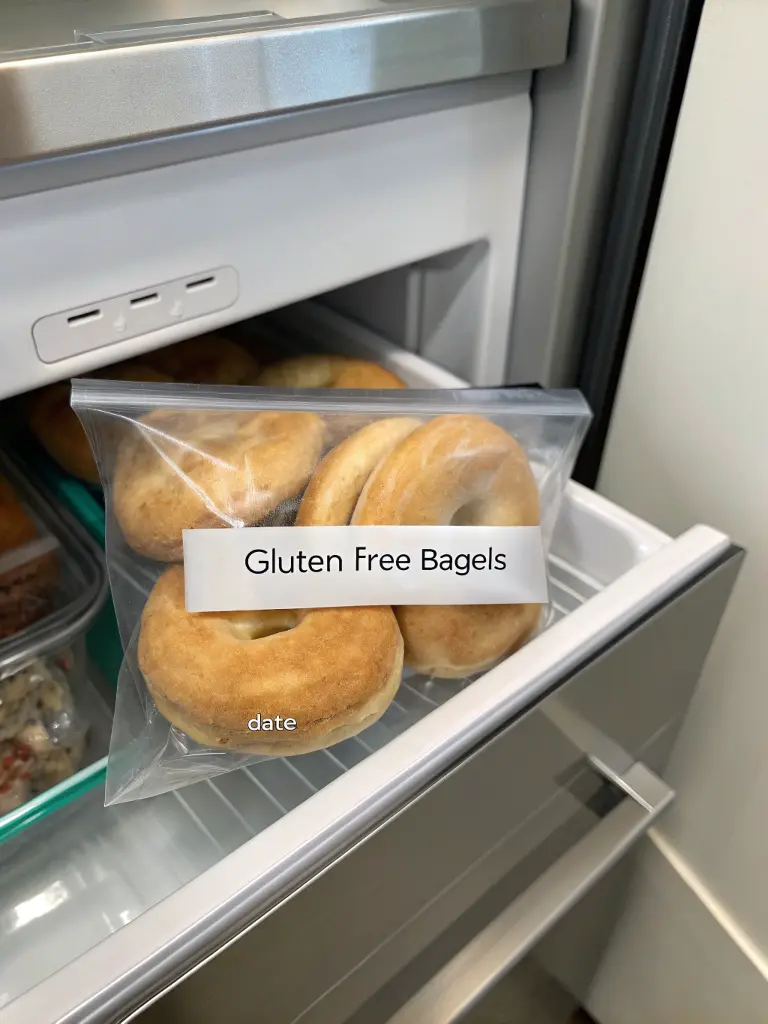
Best Ways to Store and Freeze Gluten Free Bagels
Once you’ve baked the perfect batch of your gluten free bagel recipe, the next big question is: How do you keep them fresh?
Gluten-free baked goods tend to dry out faster than their wheat-based cousins, so proper storage is key to preserving texture and flavor.
Here’s how to do it right:
Short-Term Storage (1–3 Days):
- Room Temp: Store in an airtight container or zip-top bag at room temperature for up to 2 days.
- Tip: Add a paper towel inside the container to absorb moisture and prevent sogginess.
Mid-Term Storage (4–5 Days):
- Refrigerator: Place bagels in a sealed bag in the fridge for up to 5 days.
- To refresh: Toast or microwave for 10–15 seconds before eating.
Long-Term Freezing (Up to 2 Months):
- Wrap individually in plastic wrap or parchment paper.
- Place wrapped bagels in a freezer-safe zip-top bag. Remove as much air as possible.
- To thaw: Let sit at room temperature for 30–45 minutes, then toast.
Bonus Tip: Pre-slice bagels before freezing so you can toss them straight into the toaster!
| Storage Method | Shelf Life | Best Use For |
|---|---|---|
| Room Temperature | 2–3 days | Freshly baked bagels |
| Refrigerator | 4–5 days | Daily breakfasts |
| Freezer | 1–2 months | Meal prep & batch baking |
Topping Ideas & Serving Inspiration
Don’t stop at “plain.” Once you’ve mastered your gluten free bagel recipe, level it up with these delicious combinations:
Sweet:
- Almond butter + banana slices + honey drizzle
- Whipped cream cheese + strawberries + chia seeds
- Cinnamon butter + toasted pecans
Savory:
- Avocado + poached egg + chili flakes
- Hummus + cucumber ribbons + lemon zest
- Dairy-free cream cheese + smoked salmon + capers
Looking for inspiration? Try our protein-packed cookie recipe as a sweet finish after your bagel brunch.
Frequently Asked Questions (FAQs)
How to make gluten-free bagels?
To make gluten-free bagels, start with a quality gluten free flour blend that includes or allows for binders like xanthan gum or psyllium husk. Mix the dry ingredients with activated yeast, warm water, and a little sweetener, then knead the dough. Shape into rings, let rise, boil briefly, and bake at 400°F for 20–25 minutes. A well-balanced gluten free bagel recipe delivers chewy texture and rich flavor.
How many calories in a gluten free bagel?
A typical homemade gluten free bagel contains between 180 to 250 calories, depending on the ingredients and size. Protein-rich additions or nut-based flours can increase the total calorie count. If you’re watching your intake, opt for mini bagels or skip sugar and heavy toppings.
What are the benefits of gluten free bagels?
The benefits include improved digestion (especially for those with celiac or gluten sensitivity), customizable nutrients, and higher fiber content when made with whole grain flours like oat or buckwheat. A solid gluten free bagel recipe can also support blood sugar stability when it includes lower glycemic flours such as almond or coconut.
Are gluten free bagels possible?
Yes—completely! With the right combination of flours, binders, and technique, a gluten free bagel recipe can be just as good (if not better) than traditional wheat bagels. The key is using ingredients that replicate gluten’s elasticity and structure.
Can you make protein bagels with gluten free flour?
Absolutely. You can boost the protein in your gluten free bagel recipe by adding ingredients like almond flour, pea protein powder, Greek yogurt, or chia seeds. Use these in your flour blend or as mix-ins without compromising structure or flavor.
Why are my gluten free bagels so dense?
Dense bagels usually happen because of under-proofing, too much starch, or missing binders. Be sure your dough has adequate rise time and contains xanthan gum or psyllium husk. Also, using a balanced flour blend and boiling before baking helps lighten the texture.
What is the best gluten free bagel in the world?
While brands like Canyon Bakehouse and Udi’s are popular store-bought options, many people find that the best gluten free bagel is one they bake themselves. If you’re still searching for the perfect gluten free bagel recipe, starting from scratch lets you adjust the texture, nutrition, and toppings to your exact preferences.
Conclusion
Mastering the ultimate gluten free bagel recipe is easier than you think—and totally worth it. From choosing the right flours to understanding the science behind chewiness and rise, you now have everything you need to make bagels that are light, flavorful, and completely gluten-free.
Whether you’re looking for a quick breakfast, a satisfying snack, or a high-protein meal base, homemade gluten-free bagels can be customized to suit your health needs, dietary restrictions, and cravings.
Ready to bake your own? Bookmark this guide, prep your pantry, and start experimenting. Once you try this homemade gluten free bagel recipe, you’ll never want store-bought again.
Whether you’re new to gluten-free baking or just looking for the perfect everyday breakfast, this gluten free bagel recipe is the start of something delicious.
For more mouthwatering gluten-free creations, don’t miss our partner blog Recipes Delish—packed with tried-and-true dishes your whole family will love.
Share this gluten free bagel recipe with friends or family following gluten-free diets—they’ll thank you!
Print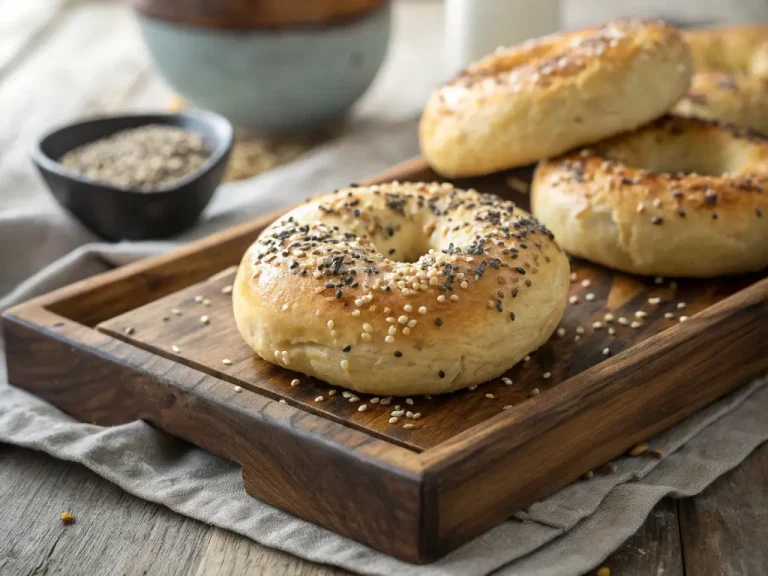
Gluten Free Bagel Recipe: The Best Homemade Guide for Chewy & Delicious Results
This easy gluten free bagel recipe delivers bakery-style results with a chewy texture, golden crust, and simple ingredients. Perfect for breakfast or snacks, these bagels are gluten-free, customizable, and freezer-friendly.
Let me know if you’d like a variation for specific dietary tags like vegan, dairy-free, or high-protein!
- Total Time: 45 minutes
- Yield: 6–8 bagels 1x
Ingredients
2½ cups gluten-free flour blend
1 tsp xanthan gum
1 tsp salt
1 tbsp sugar or honey
1 cup warm water
2¼ tsp instant yeast
1 tbsp apple cider vinegar
Toppings of choice
Instructions
Activate yeast in warm water and sugar
Mix dry ingredients
Combine and knead
Shape into rings
Proof 45 mins
Boil in water with baking soda
Bake at 400°F for 20–25 mins
Notes
Use psyllium husk for extra chew, slice before freezing for easy reheating
- Prep Time: 20 mins
- Cook Time: 25 mins
- Category: Breakfast, Gluten-Free
- Cuisine: American
Keywords: gluten free bagel recipe, chewy bagel, homemade bagels, healthy bagel, protein bagel

